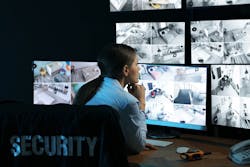As the last employees leave for the day, empty facilities such as office buildings, car dealerships and retail stores become more vulnerable to theft, vandalism, loitering and other criminal activities. It's a challenge for security directors and facility managers to find new and better ways to secure their properties overnight as criminals become cleverer and more challenging to stop using traditional systems.
Revolutionary new tools now available through advanced computer technologies and a broad acceptance of IoT devices enhance security.
These technological leaps helped create a new security concept known as remote guarding, capable of proactively preventing crime and improving security at unprecedented levels. Passive security surveillance systems become active and intelligent "digital guards" capable of alerting trained monitors of any intruders. With a protect-the-perimeter system design, perpetrators often are engaged before committing an offense, preventing crime and eliminating nuisance calls to law enforcement.
Remote guarding turns standard video surveillance cameras into digital guards through the integration of artificial intelligence technology. The guards become the first line of defense by creating a digital geofence capable of detecting human and vehicle presence and providing real-time alerts to remote security agents located in a central command center for assessment and possible engagement. Indoor detection zones may protect correctional facilities, data centers, pharmacies and other critical operational areas.
Traditionally, 95% of burglar alarm alerts were false. Adding video verification reduced that number, but still left many unnecessary calls to law enforcement for non-threatening events such as the movement of animals or wind-blown foliage. Recent AI software using machine learning algorithms, years in development, now analyzes video to eliminate false alarms by more than 90%. Fewer false alarms make human monitoring operators more effective as they concentrate on true events. The AI review process occurs in about a second and machine learning technology becomes more accurate over time without further human assistance.
Once a true event is detected, operators investigate what the camera sees before taking actions, including:
- Continuing to monitor as an intruder leaves the property without committing a crime
- The use of voice downs over public address systems at the guarded site. An operator engages intruders, letting them know they are under surveillance and requesting they leave before notifying law enforcement. Audio commands often resolve a situation
- Contacting a law enforcement dispatch center requesting an officer investigate the site
Law enforcement supports remote guarding for the added safety it brings to its officers. As officers approach a site, monitoring operators continually provide them with details from the video and audio systems. These details help officers from walking into a strange and dangerous situation and complete a likely safe call.
Also, remote guarding resolves many situations without a need to involve law enforcement. Response to minor crimes such as skateboarding, graffiti and illegal dumping has diminished in recent years due to limited law enforcement resources and budgetary constraints. The time officers spend responding to nuisance crimes takes away from their ability to address serious events. False alarms are a complete waste an officer's time.
Reducing false alarms to zero is possible with a remote guarding system that includes properly placed cameras, audio systems, AI software and well-trained operators. Another benefit: expensive false alarm fines levied by many municipalities are eliminated.
Remote guarding security solutions take ownership of many issues currently requiring law enforcement involvement. Instead of just observing, reporting, and passing the problem to law enforcement, remote guarding security solutions take a proactive approach to prevent crime before it has the chance to happen. This new and innovative approach is outperforming traditional methods of preventing crime during high-risk nighttime hours. Informal surveys of end users show reduced crime and false alarms following the deployment of a remote guarding solution.
Also, remote guarding provides effective investigation and prosecution support for the crime resolution through audio and visual recordings of the event. Recorded event data also aids in resolving accident claims and lawsuits.
A well-designed remote guarding plan provides total facility coverage. Human security guards leave areas unchecked as they patrol a site. However, they may complement remote guarding by further reducing the need to involve law enforcement for minor events.
When looking for quality remote guarding services, ask potential providers if they have their own command centers and inspect their client list to see if they have credible customers. Solution providers should also provide a free consultation to analyze the weak spots on a property before recommending equipment and placement.
About the Author:
Michael Zatulov is chief operating officer of Los Angeles-based Elite Interactive Services, a provider of remote guarding services.




